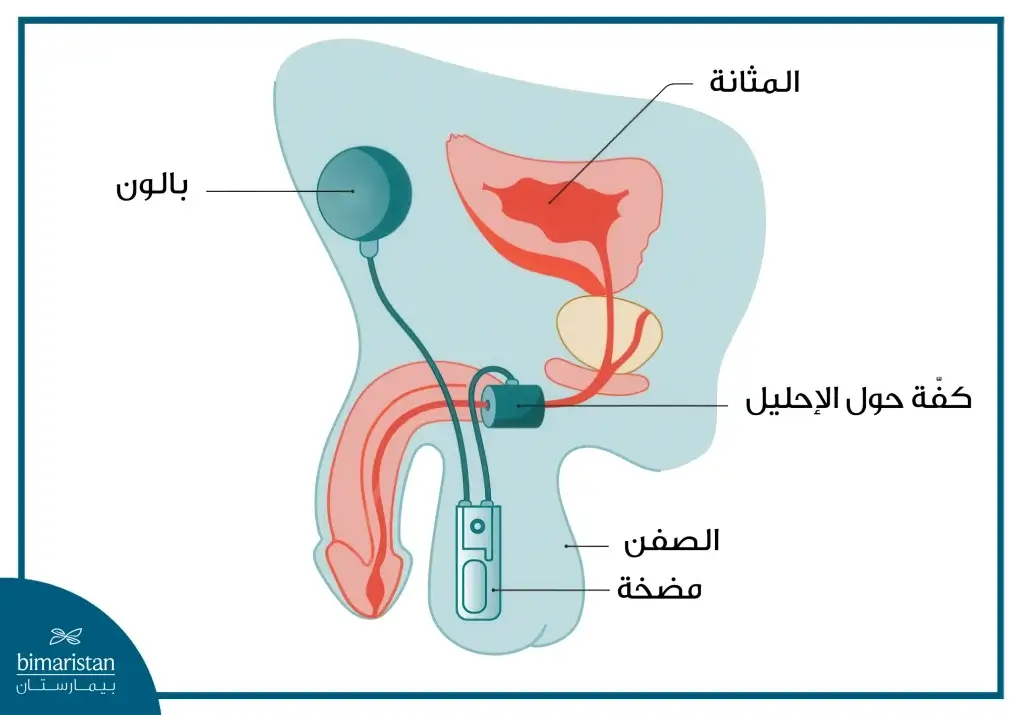يعاني نحو 11–34% من الرجال حول العالم من سلس البول بدرجات مختلفة، ما يؤثر على جودة حياتهم اليومية. قد يحدث بعد جراحة البروستاتا أو بسبب أمراض عصبية أو تقدم العمر. تتنوع طرق العلاج بين تمارين الحوض والأدوية والتدخل الجراحي مثل زرع المصرّة الاصطناعية أو حزام الإحليل. التشخيص المبكر واختيار العلاج المناسب يساهمان في تحسين السيطرة البولية.
ما هو سلس البول عند الرجال؟
يعد سلس البول عند الرجال فقدان لا إرادي للبول، وهو عرض لحالة مرضية تؤثر في آلية التحكم بالمثانة، حيث تختلف شدّته من تسرب بسيط إلى فقدان كامل للتحكم البولي، ومن أهم أنواع سلس البول عند الرجال تشمل:
- السلس الإجهادي: يحدث عند السعال أو العطاس أو رفع شيء ثقيل وذلك بسبب ضعف عضلات قاع الحوض أو الصمام البولي، وغالباً ما يظهر بعد جراحات البروستاتا.
- السلس الإلحاحي: يترافق برغبة مفاجئة وقوية للتبول مع عدم القدرة على التأجيل، وقد يكون ناتجاً عن فرط نشاط المثانة أو اضطرابات عصبية.
- السلس المختلط: يجمع بين النوعين السابقين في الأعراض.
- السلس الفائض: يحدث نتيجة امتلاء المثانة بشكل زائد وعدم تفريغها بالكامل كما في حالات تضخم البروستاتا أو ضعف عضلات المثانة.
- السلس الوظيفي: لا ينتج عن خلل مباشر في الجهاز البولي بل ينتج عن صعوبات جسدية أو عقلية تمنع الشخص من الوصول إلى الحمام في الوقت المناسب مثل حالات الخرف أو الإعاقات الحركية.
الأسباب الشائعة لسلس البول عند الرجال
تختلف أسباب سلس البول عند الرجال، وتشمل:
- التقدم في العمر
- مرض السكري
- جراحة البروستاتا
- التهاب المسالك البولية أو تناول أدوية مدرة للبول
- إصابات أو أمراض الجهاز العصبي (مثل السكتة الدماغية أو التصلب المتعدد)
الأعراض الشائعة لسلس البول عند الرجال
هناك العديد من الأعراض التي ترافق سلس البول عند الرجال، مثل:
- الشعور المفاجئ والملحّ للتبول
- صعوبة في بدء التبول أو ضعفه
- الشعور بعدم تفريغ المثانة بالكامل
- تسرب لا إرادي للبول أثناء الحركة أو الراحة
- الحاجة المتكررة لدخول الحمام، خصوصاً ليلاً
متى يتم اللجوء إلى علاج سلس البول عند الرجال جراحياً؟
يُعتبر العلاج الجراحي خيار أساسي عند فشل تمارين قاع الحوض وتعديل نمط الحياة أو العلاج الدوائي في السيطرة على سلس البول المتوسط إلى الشديد، خاصةً إذا أثر على جودة الحياة. يشمل التقييم التاريخ المرضي والفحص السريري وقياس تدفق البول لتحديد نوع السلس وكفاءة العاصرة البولية، ثم يُختار الإجراء المناسب مثل زرع العاصرة الاصطناعية أو الشريط الذكري حسب الحالة.
الجراحات المتوفرة لعلاج سلس البول عند الرجال
عندما يفشل العلاج التحفظي في ضبط سلس البول، يمكن اللجوء إلى خيارات جراحية لعلاج سلس البول تختلف حسب شدة الحالة الصحة العامة للمريض والتاريخ العلاجي، ومن أهم التقنيات الجراحية المعتمدة لعلاج سلس البول:
زرع المصرّة البولية الاصطناعية
يعتبر تركيب المصرة الاصطناعية خياراً جراحياً ممتازاً لعلاج سلس البول الإجهادي الشديد لدى الرجال، وخاصةً بعد استئصال البروستاتا الجذري. يتكون الجهاز من ثلاث قطع مترابطة: حلقة تُحيط بالإحليل وتُغلقه لمنع التسرب وخزان يُزرع في البطن لتخزين السائل ومضخة تُزرع داخل كيس الصفن يُفعّلها المريض يدوياً عند الرغبة في التبول.
خطوات العملية
يتم الإجراء تحت التخدير العام أو النصفي عبر شق صغير في العجان أو أسفل البطن حيث يتم أولاً تحرير الإحليل بدقة ثم تُركب الحلقة حوله. يُوضع الخزان في المساحة خلف العانة وتُزرع المضخة في الصفن، تُملئ المكونات بالسائل المتوازن وتُوصّل بأنابيب دقيقة، يُترك الجهاز غير مُفعّل لعدة أسابيع حتى اكتمال الشفاء ثم يتم تفعيله في العيادة.
نسبة النجاح
تتجاوز 85–90% من حيث السيطرة الكاملة أو الجزئية على التسرب البولي مع تحسن واضح في جودة حياة المريض.
المضاعفات المحتملة
تشمل العدوى وتآكل الإحليل وربما تعطل الجهاز أو الحاجة لإعادة الجراحة (Revision surgery) خلال سنوات الاستخدام خاصةً عند الاستخدام طويل الأمد أو في حال وجود أمراض مزمنة مرافقة مثل السكري.

حزام الإحليل الذكري
يُستخدم حزام الإحليل لعلاج سلس البول الإجهادي الخفيف إلى المتوسط ويعتبر خيار أقل تدخلاً جراحياً من المصرّة الاصطناعية، يعتمد على دعم الإحليل لإعادة التوازن الطبيعي بين الضغط داخل البطن وضغط الإغلاق الإحليلي وهذا ما يقلل من التسرب دون حاجة إلى أجهزة ميكانيكية.
خطوات العملية
يُجرى تحت التخدير العام أو النصفي من خلال شق صغير في العجان حيث يُوضع الحزام المصنوع عادةً من مادة شبكية صناعية تحت الإحليل ويتم شده بدرجة مناسبة لتوفير الدعم دون ضغط مفرط، كما أنّه لا حاجة لمضخة أو خزانات. تُثبت أطراف الحزام بعظام الحوض أو عضلاته حسب نوع التقنية.
نسبة النجاح
تتراوح بين 70% إلى 90% مع درجات تحسن متفاوتة حسب شدة السلس. المرضى الذين لم يخضعوا لعلاجات إشعاعية أو لم يكن لديهم تليف شديد في العجان يعدّون مثاليين.
المضاعفات المحتملة
تشمل احتباس البول المؤقت وألم موضعي أو فشل في تحقيق التحسن المطلوب ولكن المضاعفات الكبرى أقل حدوثاً مقارنةً بجراحة AUS.
حقن المواد المالئة
تعتبر هذه التقنية الأقل توغلاً لعلاج سلس البول وتُستخدم عادة في الحالات الخفيفة أو للمرضى غير المناسبين للجراحة الكبرى، تعتمد على حقن مواد صناعية أو بيولوجية حول جدار الإحليل لتعزيز قدرته على الانغلاق وتقليل التسرب.
خطوات الإجراء
يتم الحقن عبر منظار بولي يتم إدخاله من الإحليل تحت التخدير الموضعي أو الخفيف حيث تُحقن المواد (مثل Durasphere أو Macroplastique) في موقع معين حول الإحليل الداخلي مما يُضيّق تجويفه جزئياً ويحسن الإغلاق أثناء الجهد أو السعال.
نسبة النجاح
وتُقدّر بنحو 40–60% من المرضى الذين يلاحظون تحسناً أولياً، لكن الكثير منهم قد يحتاجون إلى تكرار الحقن خلال 6–18 شهراً للحفاظ على النتائج.
المضاعفات المحتملة
نادراً ما تحدث لكن تشمل التهيج الموضعي، الالتهاب أو فشل التحسن. تعد آمنة لكنها محدودة الفعالية في الحالات المتقدمة.
المتابعة بعد الجراحة ونصائح الوقاية من التكرار
بعد الجراحة، تبدأ مرحلة المتابعة لضمان نجاح العلاج ومنع المضاعفات، حيث تُجرى الزيارات المنتظمة بعد 6–8 أسابيع لتفعيل الجهاز وتقييم الجرح ووظيفة المصرة، مع متابعة دورية لاحقة حسب الحاجة. تُقدّم للمريض إرشادات حول استخدام الجهاز والامتناع عن النشاطات المجهدة واتباع نمط حياة صحي. كما أن إعادة تأهيل عضلات قاع الحوض بعد الجراحة قد يحسن السيطرة البولية ويعزز النتائج على المدى الطويل.
لماذا تُعدّ تركيا الخيار الأمثل لعلاج سلس البول جراحياً عند الرجال؟
تعد تركيا من أبرز الوجهات العالمية في علاج سلس البول عند الرجال وذلك بفضل توفر بنية تحتية طبية متقدمة وخبرة تراكمية في هذا النوع من الجراحات، ويعود تميزها إلى عدة عوامل:
- تقنيات حديثة
- كفاءة الجراحين
- تكلفة مدروسة
- رعاية شاملة للمريض
- سهولة الوصول للمراكز الطبية
تتوفر في تركيا تقنيات متقدمة وخبرات جراحية عالية لعلاج سلس البول عند الرجال، مع متابعة دقيقة وخدمات شاملة تضمن نتائج فعّالة. يمكن للعلاج الجراحي تحسين جودة الحياة بشكل كبير عند الحالات المتوسطة والشديدة التي لم تستجب للعلاجات التحفظية. الالتزام بالتعليمات الطبية وإعادة تأهيل عضلات الحوض بعد الجراحة يعززان نجاح العلاج على المدى الطويل. المعرفة والوعي بالحالة يساعدان الرجال على التعامل مع سلس البول بثقة وراحة أكبر.
المصادر:
- Parsons, J. K., & Hu, J. C. (2022). Urinary Incontinence in Men. In StatPearls. StatPearls Publishing.
- MedlinePlus. (2023). Urinary incontinence – male. U.S. National Library of Medicine.

